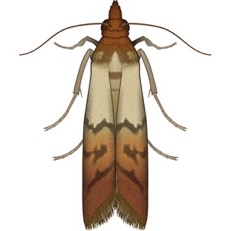
Defining stored product pests
Stored product pests fall into two main insect orders:
- Coleoptera (beetles)
- Lepidoptera (moths).
Within each group, some species are considered as primary pests, they attack the whole grain, while others follow the initial damage as secondary pests. Losses can amount to 10% or more of the commodity through spoilage or secondary fungal infection.
Understanding Primary and Secondary Pests
Primary coleopteran pests include grain weevils (Sitophilusgranarius, S.zeamais, S.oryzae),the lesser grain borer (Rhyzoperthadominica) and the saw-toothed grain beetle (Oryzaephilussurinamensis.)
Secondary beetle pests include the flour beetles (Triboliumconfusumand T.castaneum)
The main lepidopteron pests are secondary; they feed regularly on processed foods so are more common in domestic kitchens and larders.
A variety of pests infest stored grain. This may occur in succession – primary then secondary. Eggs are laid in the grain or part-processed food (flour, bran etc.) where the larvae feed through to the pupal stage.
Moth larvae usually fly to a hidden site away from the food source to pupate, adults then mate and eggs are deposited on or in suitable food.
Emerging beetle adults feed on grain or find shelter in the structure of the silo/warehouse prior to invading new food sources.
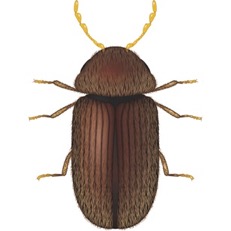
Biscuit Beetle
Classification
Species category: Stored product pest
Scientific name: Stegobium paniceum
Family: Anobiidae
Description
Oval shaped and reddish-brown in colour, the adult is 2-3.5mm long. The have a cylindrical body that appears to be humped and are covered in dense short yellowish hairs.
The Biscuit Beetle, which is also commonly known at the Drugstore Beetle, has distinctive longitudinal grooves along its wing cover and its antennae end in three enlarged segments.
A cosmopolitan pest, it can be found all across the world but is particularly prevalent in warmer regions and can survive in heated structures in more temperate climates.
They are fond of warmth and so are widely prevalent in shops and domestic larders, infesting a wide variety of dried matter and stored food products. It is also a serious pest of agricultural grain storage.
Behaviour
A pest of cereal products e.g. flour, bread, it is an indiscriminate eater and will feast on a wide variety of products from furs and leather to spices and even pharmaceutical products.
With such a varied diet it is found in a wide range of places, as it will survive on any type of food. These insects are winged but tend to travel by transferring from one food source to the next.
It lays its eggs on a food source and once they begin to hatch the larvae continue to feed on the food. In a warm atmosphere, there may be as many as four generations per year.
Risks
Biscuit beetles feed on a wide range of cereal crops and beverage concentrates. Infested products may be contaminated and products and packaging may be damaged. The larvae are able to penetrate tinfoil and sheet lead. Books and manuscripts may also be attacked
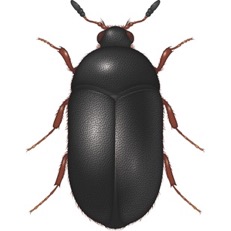
Black Carpet Beetle
Classification
Species category: Beetles & Weevils
Scientific name:Attagenus unicolor
Description
Small and oval shaped, the Black Carpet Beetle is a black colour with brown legs and short antennae. The adult will reach 3-5mm in length. The larvae, which are the true pests of this species, are typically longer in body length and are a reddish-brown colour.
Black Carpet Beetles are found throughout Australia.
Carpet beetles are as common in food pantries as they are in a carpet or wardrobe. However, as the name suggests, Carpet Beetles are often prevalent in the carpet’s pile but this is not their only habitat. Evidence of an infestation is not just the insects themselves but also the larvae which continuously moult before adulthood, leaving behind tell-tale shells and lots of destruction.
Behaviour
These flying insects are mainly considered a pest because of their destructive larvae that feast on a wide variety of keratin based animal products including wool, silk, hides and furs. The larvae have also been known to feed on synthetic products too, in addition to household foods and dead insects.
There are a number of moulting stages between larvae and reaching full adulthood. The larvae enjoy a warm, dark environment while the beetle is drawn to the light.
Risks
This insect damages animal based materials in homes e.g. wool, silk, fur etc… They eat large irregular shaped holes in a wide variety of fabrics. The larvae also leave behind shells as they moult, which are a known cause of allergies in some humans.
They are often spotted in the home as they crawl across the surface of fabrics and tend to feed at the top of the carpet rather than down in the base fibres.
Commonly found feeding on dried foods also, they contaminate it with faeces and discarded shells.
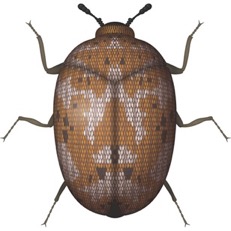
Carpet Beetle
Classification
Species category: Beetles & Weevils
Scientific name: Anthrenos Verbasci
Family: Dermestidae (skin feeders)
Description
All carpet beetles are between 2-4mm long with the exception of the Fur Beetle which is 4.5-6mm long. The Varied Carpet Beetle is brown or black and mottled with yellow or white scales. The Fur Beetle is black and covered in white hairs.
The varied carpet beetle is indigenous to Europe and in England. The furniture carpet beetle is of a subtropical origin and cold sensitive.
Warm, dry conditions are ideal for Carpet Beetles’ development but they can survive in foodstuffs with very low moisture content. The Museum beetle is often found in museums where it is a particular pest of dried specimens. The Fur Beetle may be found in fur, skins, textiles and grain.
Adult carpet beetles are found outdoors and live off pollen and nectar.
Behaviour
Pests of animal products and occasionally food products of plant origin, Carpet Beetles are major textile pests. They thrive in situations where they remain undisturbed, e.g. beneath carpets and around skirting boards.
Risks
Larvae cause considerable damage to keratin-containing products such as wool, fur and leather. Occasionally food products of plant origin can be attacked.
Damage takes the form of clean irregular holes in textiles. There’s no webbing or excrement present, so by the time larvae are observed, considerable damage has often occurred.
Carpet beetles are not a health hazard but are potential vectors of anthrax.
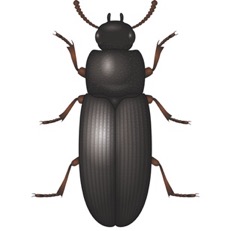
Flour Beetle
Classification
Species category: Stored product pest
Scientific name: Tribolium Castaneum
Family: Tenebrionidae
Description
There are many different species of Red Flour Beetle ranging from 2.3- 5.75mm in length. As the name suggests, they are Reddish-brown in colour or black/brown. Although small in size, they have a long body and distinctive segmented antennae with three large club-like segments at the end.
They are cosmopolitan insects and found readily all across the world.
Serious pests of cereal products, including grain, flour, porridge oats and rice bran. Flour beetles are most commonly encountered in bakeries, flour mills and other agricultural stored grain areas.
Other products which may be attacked are oil seed, oil cake, nuts, dried fruit, spices, chocolate – even bones and other animal products.
Behaviour
The beetle lays its eggs in damaged grain and are prolific reproducers, laying 100s of eggs in a breeding season. They are not cold hardy, so only overwinter under warm conditions.
They reside in the smallest of crevices, and are a particular problem in machinery where cereal and other food residues accumulate.
Risks
Flour beetles are a secondary grain pest and increase the feeding damage done by primary pests. When present in large numbers, flour beetles:
Make flour prone to moulding and will also turn the product grey.
Taint commodities with secretions from scent glands.
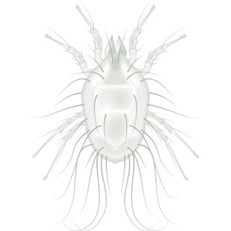
Grain Mite
Classification
Species category:Mites
Family: Acaridae
Description
2 different species:
1. Grain mite - Lepidoglyphus destructor
2. Storage/Mould mite - Tyrophagus longior
Just visible to the naked eye, these mites reach 0.5mm in length and can be seen moving slowly on the surface of grain or associated produce. Grain mites are commonly a pale, grey to white colour.
Larvae have 6 legs and they increase to 8 legs during the nymph to adult stage.
Have a wide distribution, especially in warmer climates. However, they can be found in warm grain stores worldwide.
They thrive in warm, moist conditions and prefer humidity levels of 80% with an optimum temperature of 20oC. These mites will survive colder conditions but will die without moisture.
Behaviour
Both species require a high moisture habitat and are common in food processing where stored produce is kept at a high humidity level, which also results in fungal growth.
A female will lay hundreds of eggs during the course of her lifecycle. Eggs are laid daily and are distributed singly or scattered across the surface of the grain. Egg to adulthood is a short phase so an infestation can take hold quickly.
These mites have a unique phase in the lifecycle called the hypopus, this is a nymphal resting stage, where the young mites don’t feed and are more resistant to control measures.
Risks
The Grain Mite feeds on a wide variety of products, cereals, dried vegetable materials and dried fruits.
Mite populations in grain stores can build up very quickly. They have a preference for feeding on the cereal germ and contaminate grain with allergens that adversely affect its palatability. They also feed on mould and spread fungal spores, further damaging the grain.
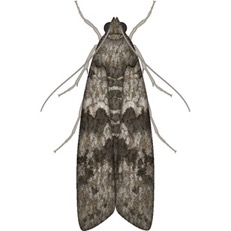
Mediterranean Flour Moth
Classification
Scientific Name: Ephestia kuehniella
Family: Pyralidae
Description
The Mediterranean Flour Moth has forewings which are grey in colour with darker mottling, their hind wings tend to be paler. Adults have a 20-25mm wingspan. Larvae tend to be pinkish/white and can have dark underside spots.
A native of Central America, the Mediterranean Flour Moth is now a cosmopolitan species.
It is a particular problem in provender mills, bakeries and occasionally even in catering premises. One generation is usually produced but in warm conditions, adults will be present throughout the year and may produce 4-6 generations.
Behaviour
Most active from dusk until dawn, it rests during the day. This species is a particular pest of flour mills.
Mating takes place immediately after the adults emerge. Up to 350 eggs are laid and these may be stuck to various foods by a sticky secretion. The eggs hatch in 4-28days and the larvae spin silken tubes in which they live. After 3-5 moults the larvae are fully grown and 15-19mm long.
Risks
Larvae present a more serious problem, as it is their feeding and excretions that contaminate the produce. The adults do not feed.
The larvae produce copious amounts of silk which contaminates grains but this larval webbing also causes serious blockages in provender mills. The larvae eat holes in sifting silks and may also reach mill’s finished products.
The webbing may also cause condensation which leads to damaging molds.
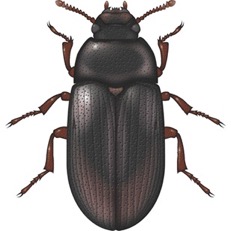
Lesser Mealworm
Classification
Species category: Beetles & Weevils
Scientific name: Alphitobius diaperinus
Family:Tenebrionidae
Description:
Typically, an adult will reach 5.5-6.7mm in length and is shiny dark-brown or black. The long oval body has longitudinal strips of perforation-like indentations on the wing cover. They also have multi-segmented antennae which are paler at the tips.
Region:
A cosmopolitan species, it is believed to be a native of sub-Saharan Africa but is now readily found across the world.
Habitat:
In temperate climates, they are typically found indoors although, being reasonably cold tolerant, they will survive in unheated buildings.
The Lesser Mealworm beetle is widely distributed in animal houses and especially poultry houses where the conditions reflect those of its tropical origin.
Behaviour:
Lesser Mealworm Beetles are associated with a variety of stored products. This pest favours humidity and warmth and is most prevalent in environments that offer a combination of both.
They eat an extensive variety of foods from carrion to insects and fungus to grain. These nocturnal creatures can lay 100s of eggs in a lifetime, which it lays on a food source for the larvae to thrive.
Risks:
Known vectors of diseases, particularly poultry diseases, they present a significant threat to poultry houses where they transmit Marek’s disease, and Newcastle disease, amongst others.
Lesser Mealworm beetles infest a range of stored products including cereals, farinaceous products, oilseeds, groundnuts and bones but are not regarded as major pests in this area as they select grains that have been previously damaged by for e.g., moulds.
Their presence is an indication of poor hygiene. Infestations in animal houses are often introduced by way of contaminated feed.
When looking for a suitable pupation site, the larvae chew holes in a wide variety of materials from building insulations through to timbers, causing destruction.
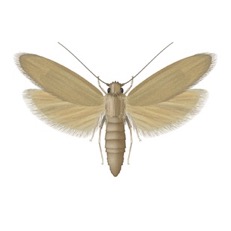
Rice Moth
Classification
Scientific Name: Corcyra cephalonica
Family: Pyralidae
Description
The Rice Moth has a pale, buff-brown colour which is uniform and features no distinctive markings, the veins may appear darkened and the hind wings are almost translucent. It has a 15-25mm wingspan.
The larvae are dull, yellowish/white body and a dark brown head. They have long fine hairs that cover their body.
A native of the tropics, it now has a widespread distribution and is even found in the countries of Northern Europe, where it has been imported in foodstuffs.
This tropical species typically enjoys a warm climate but in temperate areas it can survive all year in heated stores. It is a major pest of stored foods and favours grains, particularly rice. They are common in flour mills but can be seen in all types of stored food areas.
Behaviour
This moth attacks grains, especially rice, but will also eat oil seeds, cocoa beans, dried fruit and spices.
It lays up to 160 eggs on or near a food source. The larval stage lasts 15-20 days in favourable conditions and the larvae will produce masses of strong webbing which it uses to form a dense cocoon in order to pupate. This stage will last 7-10 days.
Risks
Rice moth larvae contaminate food by producing large amounts of strong webbing and frass. This can bind food together and make foods unsuitable for sale or consumption.
Frass from the rice moth can also attract other stored food pests and increase the damage and contamination of the product.
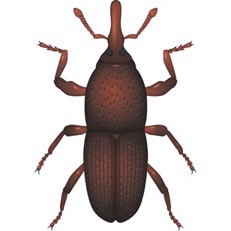
Grain Weevil
Classification
Scientific name: Sitophilus granarius
Family: Curculionidae
Description
There are 3 different species:
Sitophilus granaries (Grain Weevil)
Sitophilus oryzae (Rice weevil)
Sitophilus zeamais (Maize Weevil)
Each of these species varies considerably in size but has a distinctive elongated snout which is adapted to the size of its preferred grain. Typically, they reach 2-4mm in length and have a long cylindrical body which is dark brown or nearly black in colour.
Grain weevils are encountered in all temperate and warm-temperate climates. They are widely distributed around Europe. Both adults and larvae are cold-hardy.
Rice and Maize weevils are widely distributed in tropical and sub-tropical areas and will be carried to temperate areas on imported commodities.
The maize weevil breeds on maize in the field but the Rice weevil only breeds in stored grain. Both insects will not normally overwinter in unheated premises or grain stored at normal temperatures.
Behaviour
Grain weevils do not fly but instead, infestations often occur after being imported in grain and cereal products, also from the fabric of vehicles used to transport grain or buildings to store it.
The female will lay a single egg inside the grain, where larva and pupa stages will occur, once developed, the weevil bores its way out leaving a hole in the grain.
The Grain weevil can only breed in grain with moisture content of more than 9.5% and at temperature within the range 13-35C.
Risks
Grain weevils are primary grain pests, infesting undamaged grain and attacking other hard cereal products such as macaroni and spaghetti. Weevil-damaged grain is readily recognised by the presence of large holes which are the exit holes of the emerging adults.
Both the adults and the larvae feed on the grain causing holes and also contamination with their excretions. Grain quality and marketability is reduced.
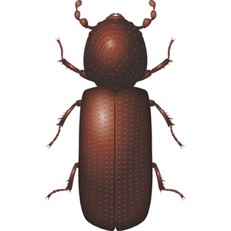
Lesser Grain Borer
Classification
Scientific name: Rhyzopertha Dominica
Family: Bostrichidae
Description
2.3-3mm in length, the Lesser Grain Borer has a long, cylindrical body that is a dark red-brown/black colour. The head and abdomen feature rows of tiny indentations and the antennae finish with 3 larger segments that form a club.
The Lesser Grain Borer originated in South America but is now a cosmopolitan pest especially in warmer countries.
It is not cold hardy pest and development is limited at temperatures less than 23°C. Infestations are typically in grain stores including ships holds, flour mills and animal feed mills. They have also been recorded in woods and books.
Behaviour
In Australia and India, it is a serious pest of grains. Grain borers are associated with a wide variety of vegetable materials including wheat, barley, maize, rice, millet, sorghum, dried potatoes, dried herbs and biscuits.
The female lays single or multiple eggs on the outside of the grain but the egg goes through its developmental phases in the hollowed core of the grain.
An infestation is characterised by a sweet yet unpleasant, musty smell from excretions and shed skin.
Risks
Lesser grain borers are primary pests of grain and can attack undamaged grain, rendering it susceptible to attack by secondary pests.
Both the adults and larvae feed on the grain creating a floury dust and potentially, leaving little behind except for the empty husks.
The adults are active and may infest a large number of kernels whilst the larvae penetrate kernels and develop within the grain.
They significantly reduce the market value of stored grain.
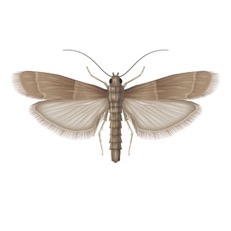
Tropical Warehouse Moth
Classification
Species category: Stored product pest
Scientific Name: Ephestia Cautella
Family: Pyraloidae
Description
Typically an adult moth has a 12-18mm wingspan and is distinguished by an upper forewing which is dull grey-brown with a dark inner band that trails the outer edge of the wing and a broad pale band along inner edge.
The larvae are dirty white or may be tinged brown or have purple spots.
It has a cosmopolitan distribution and has spread throughout the world by travelling on imported stored food produce.
A tropical or subtropical species which is frequently located on imported cargoes. It is common in food production warehouses, particularly dried fruits, chocolate and cereal, where the larvae develop by chewing and feeding on produce.
Behaviour
Commonly also referred to as the Almond moth or Dried Currant Moth, it is typically found in dried fruit and nuts, although it will attack cereals, oil seeds and chocolate products.
Egg laying commences within 24 days of the adults emergence and up to 350 eggs are laid during the first 4 days. Where temperatures are low the moth overwinters as larvae.
It’s the larvae that damage produce; the adults do not feed and have a short lifespan.
Risks
Moth Larvae cause considerable damage to stored goods by chewing, feeding and contaminating with webbing and frass.
Adult insects are not responsible for damage as they either feed on liquid food and water or do not feed at all.
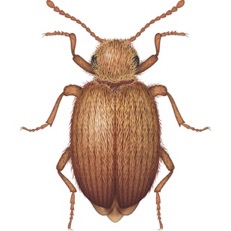
Spider Beetle
Classification:
Species category: Beetles & Weevils
Family: Ptinidae
Description:
There are 4 key species:
1. Ptinus tectus (Australian Spider Beetle)
2. Ptinus fur (White Marked Spider Beetle)
3. Niptus hololeucus (Golden Spider Beetle)
4. Gibbium psylloides (Hump Spider Beetle)
Varying in size by species, these insects are on average 1.7-4mm in length and have a dull-brown/red body with golden hairs. The Hump Spider beetle is different and has a shiny, red-brown to black body with no hairs.
Spider Beetles have 11 segmented antennae and all share a number of spider-like characteristics including a stout body, long legs and generally, a hairy appearance.
Behaviour:
Gregarious and nocturnal, Spider Beetles spend the day in cracks and crevices amongst packaging and the fabric of a building. They thrive in old buildings where they find safe harbourages.
Spider beetle larvae infest all types of dry animal and vegetable matter including grain, spices and fish meal. They will scavenge on debris and bore holes in order to find a safe place to pupate. In doing so, they destroy packaging and contaminate foods.
There are 2-4 generations per year in unheated conditions. All stages except eggs and young larvae can overwinter. Peak activity is reached between August and November.
Region:
The Australian Spider Beetle is Australasian in origin and now is widely distributed. Most spider beetle species are cosmopolitan and are rarely imported.
Habitat:
They enjoy dark and damp conditions and readily feed on moisture-damaged food. Infestations often originate from birds’ nests. Spider beetles are becoming increasingly common in domestic premises where they are found in attics, wall cavities and floorboard cracks.
Granaries and bakeries also offer the perfect conditions and food sources. Hump Spider beetles are tolerant of cool conditions and can survive for long periods without food supplies.
Risks:
Spider beetles can reduce the quality of commodities by contaminating them with webbing and droppings. The larvae bore into packaging and the grain itself, in addition to other materials such as grain sacks, leaving behind tell-tale holes.
Experts in Pest in Food control in Melbourne, Ballarat and Geelong- Redknight
All treatment comes with warrantees.
